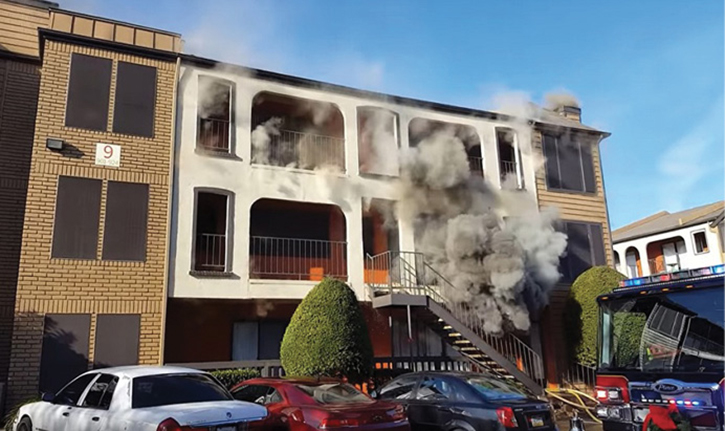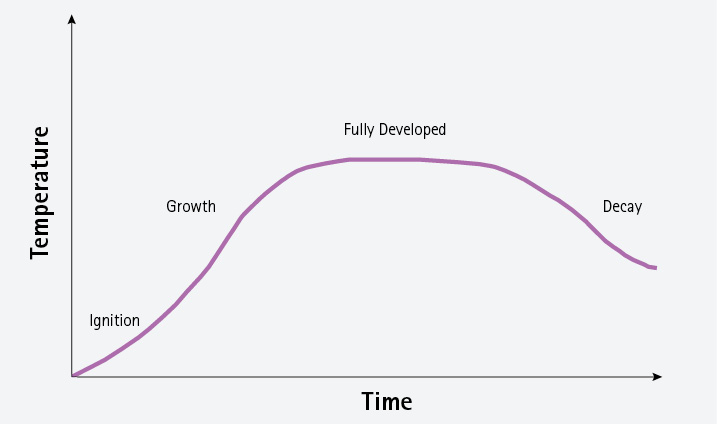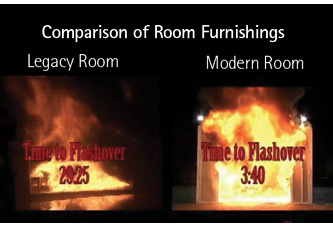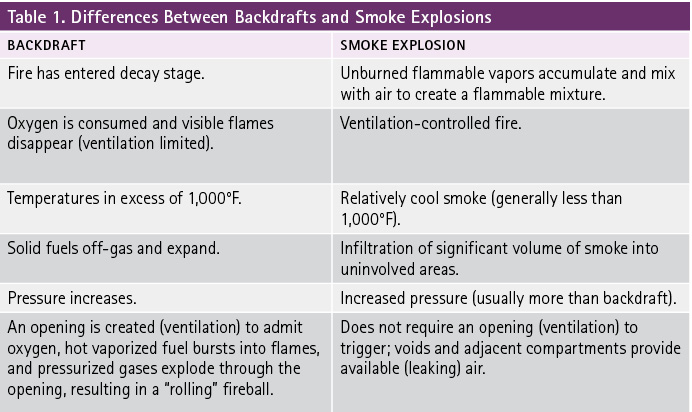
For many years, fire service members have been debating over the three fireground phenomena: flashover, backdraft, and smoke explosion. Modern technology allows us to view examples of these phenomena through online video footage and educational fire blogs. Sometimes, it can be difficult to differentiate one event from the other, hence the debates.
Fire Triangle, You Say? The Fire Decagon and Fire Behavior
Many of us believe we have a pretty good understanding of flashover, backdraft, and smoke explosion, but we sometimes see an event that does not seem to be so clear-cut, like the difference between a backdraft and a smoke explosion. Some references, such as the National Fire Protection Association (NFPA), recognize a smoke explosion as a backdraft, but there are some differences between the two, which we will discuss.
It’s also important to understand where flashover, backdraft, and smoke explosion occur within the modern stages of the “fire bell curve” (Figure 1). This article reviews the definitions of each trigger event for clarity. Understandably, definitions can differ slightly from one resource to another.
Figure 1. Modern Stages of the Fire Bell Curve

Illustration courtesy of NIST.
Flashover
This is the transition phase in the development of a contained fire where surfaces that are exposed to the thermal radiation from fire gases in excess of 1,112°F (600°C) reach an ignition temperature (more or less) simultaneously and spread fire rapidly through the space. As shown in photo 1, flashover is achieved in a much shorter time using modern furnishings as compared to legacy furnishings.
According to the National Institute of Standards and Technology (NIST), this is the most dangerous stage of fire development. Flashover occurs between the growth and fully developed stages of burning, primarily. However, flashover may also be possible during the decay stage, when oxygen (O2) is consumed but hot gases remain. The introduction of air can trigger these hot gases to ignite and flash over.

(1) Testing done for a flashover involving modern room furnishings. (Photo courtesy of UL Firefighter Safety Research Institute.)
The NFPA recognizes the following characteristics of flashover:
- Hot gases rise to the ceiling and spread across to the walls.
- Heat radiates downward and intensifies until all combustible items reach their ignition temperatures and burst into flames.
- Temperatures soar to as much as 1,000°F near floor level in a few seconds. Even a firefighter in full protective gear is unlikely to survive a flashover.
Firefighters are trained to recognize the signs that flashover is about to occur—i.e., dense black smoke with tightly packed curls (“black fire”), dense black smoke that pushes out of a doorway or window opening, or smoke that has accumulated at doorknob-height level with the fire seen below.
Backdraft
As per NIST, this is a rapid deflagration (explosion) following the introduction of O2 into a compartment filled with accumulated unburned fuel. Backdraft occurs within the decay stage of burning.
The NFPA recognizes the following characteristics of a backdraft:
- A fire burning in a confined area consumes all the O2.
- Visible flames disappear. Solid fuels smolder, and hot flammable gases accumulate and fill the room.
- The temperature increases, the gases expand, and pressure builds, pulsing against doors and windows. From outside, the building may look like it is breathing or throbbing.
- If an opening is made to admit O2, the hot vaporized fuel bursts into flames, and the pressurized gases explode through the opening, resulting in a “rolling” fireball.
Smoke Explosion
This occurs when unburned pyrolysis products and flammable products of combustion accumulate and mix with air, forming a flammable mixture and introducing a source of ignition that results in a violent explosion of the premixed fuel gases and air.
It is very difficult to predict a smoke explosion. However, the following indicators point to the potential for this phenomenon to occur:
- Ventilation-controlled fire (inefficient combustion producing substantial amounts of unburned pyrolysis products and flammable products of incomplete combustion).
- Relatively cool (generally less than 600°C or 1,112°F) smoke.
- Presence of void spaces, particularly if they are interconnected and have combustible structural elements.
- Infiltration of significant amounts of smoke into uninvolved exposures.


(2) A smoke explosion at an apartment fire in Texas. (Photo courtesy of Joe Montalbano.)
Reviewing the definitions above, it is fairly easy to differentiate a flashover from a backdraft or smoke explosion. However, this becomes more difficult when differentiating between a backdraft and a smoke explosion. As mentioned above, some references classify a smoke explosion as a backdraft. However, there are subtle differences. Table 1 compares the two.
A smoke explosion is basically a relatively cold-smoke environment in which flammable vapors (smoke) have collected significantly in voids or an adjacent compartment from the fire area. A smoke explosion does not require us to make an opening on the perimeter to create ventilation; it gets its air through leaking air that seeps into the space or is readily available in the compartment and void spaces.
Think about an investigation call for a haze of smoke. The haze is cold smoke, but the mixture of smoke and air is probably pretty close to the flammable range, absent an ignition source. Firefighters tend to feel safe in this type of smoke environment because of good visibility, and usually they are not masked up, but it has the potential to blow in the presence of an ignition source if vapors are within the flammable range.

(3) This backdraft occurred during a test in a burn container. (Photo courtesy of Dräger, Inc.)
A smoke explosion is more difficult to predict than a backdraft. However, by following the modern firefighting principles identified through scientific studies provided by NIST and Underwriters Laboratories, we can reduce the likelihood of trigger events like flashover and backdraft by effectively cooling the environment with a sufficient volume of water as quickly as possible, followed by effective and cautious ventilation to clear accumulated smoke and flammable vapors.
Regardless of the ventilation method you use (vertical or horizontal), consider the best method for the fire you’re on to cautiously ventilate and control the environment as safely as possible and to prevent the trigger event from occurring.
Although each of the outlined trigger events is dangerous to firefighters, the flashover continues to be the most frequent and most dangerous event firefighters can encounter. The debates will continue; perhaps the only way to truly know which type of event occurred on any given fireground is through an independent analysis.
Science continues to do its part to bring clarity to better understand these phenomena. Nevertheless, it is extremely important for firefighters to know and understand each of these three phenomena so they can identify them and their characteristics on the fireground and be familiar with the proper methods available to combat them and to limit their potential.
References
https://ulfirefightersafety.org.
NFPA 921 Guide for Fire and Explosion Investigations, 2017 Edition.
Bengtsson LG. Enclosure Fires (2001). Swedish Rescue Services Agency. Retrieved from https://www.msb.se/RibData/Filer/pdf/20782.pdf.
NICK J. SALAMEH is a 36-year fire service veteran. He was a fire/emergency medical services captain II and was previously a training program manager for the Arlington County (VA) Fire Department, with which he served 31 years. Salameh is also a former chair of the Northern Virginia Fire Department Training Committee. He is a contributor to Fire Engineering and Stop Believing; Start Knowing.

